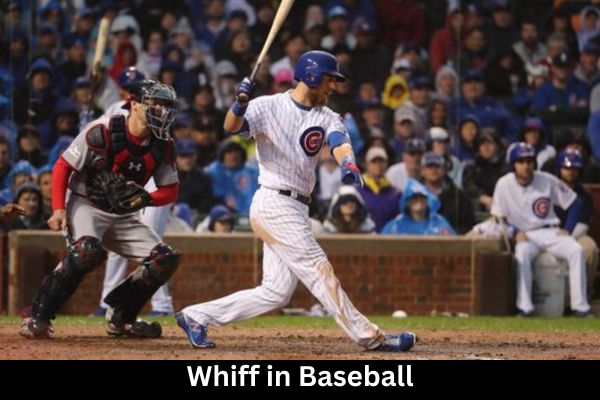 Image Credit-Pinterest
Image Credit-Pinterest
In the realm of baseball, a “whiff” is more than just a missed swing; it’s an emblem of anticipation turned to empty air. Picture this: A pitcher winds up, propelling a fastball towards the batter’s box. Eager to connect, the batter takes a powerful swing, yet the ball evades the bat, leaving it slicing through the vacant space.
This introductory dive into the essence of a whiff sets the stage for unraveling its intricacies. It’s not merely a momentary lapse but a crucial element that shapes the dynamics of the game. Let’s explore the layers beneath the surface, understanding why a whiff holds more weight than meets the eye.
Also Read: Exploring T-Mobile Park
Whiff vs. Strikeout
In the vernacular of baseball, the terms “whiff” and “strikeout” are often intertwined, yet each carries its own distinct nuance. A whiff, as we’ve established, is the art of swinging with intent only to miss the incoming pitch. On the other hand, a strikeout encompasses a broader spectrum of ways a batter can be retired, not limited to swings and misses.
Deconstructing the Batter’s Struggle
While a whiff specifically denotes a swing and miss, a strikeout encompasses a trio of scenarios. First, there’s the familiar whiff—the swing that ends in vain. Then, there are “looking strikes,” where a batter watches a pitch within the strike zone without swinging. Finally, “foul strikes” occur when a batter hits the ball into foul territory with two strikes already against them.
Understanding these distinctions is pivotal to decoding the chess match between pitcher and batter, where every swing, or lack thereof, shapes the outcome of the at-bat.
Ways to Whiff
Now that we’ve grasped the essence of a whiff, let’s dissect the diverse scenarios that lead batters to this moment of missed connection. A swing and a miss can unfold in various ways, revealing the intricacies of the batter’s struggle.
- Overestimating Pitch Speed: Batters, in their eagerness, may swing too early, anticipating a fastball’s velocity but finding themselves swinging through empty air.
- Misjudging Pitch Location: A critical aspect is recognizing the pitch’s trajectory accurately. Swinging at a ball outside the strike zone is a common pitfall, resulting in a whiff.
- Losing Balance or Timing: Solid contact requires more than just intent. Batters must maintain proper balance and timing, elements that, when off-kilter, lead to swings that fall short.
- Freezing on a Surprise Pitch: Crafty pitchers often deploy unexpected pitches, causing batters to freeze momentarily, only to swing too late or in the wrong spot.
By exploring these facets, we gain insight into the delicate dance between pitcher and batter, where split-second decisions can be the difference between a powerful connection and a whiff.
Also Read: AAA in Baseball
Stats and Whiff Rates
Now, let’s delve into the statistical realm, where numbers paint a vivid picture of the impact of whiffs on the game. Understanding key metrics like whiff rate, swinging strike rate, and strikeout rate offers a deeper appreciation of the strategic battles on the baseball diamond.
Whiff Rate
This metric measures the percentage of swings that result in a miss. A high whiff rate indicates vulnerability to strikeouts, while a low rate suggests disciplined contact.
Swinging Strike Rate (SwStr%)
Similar to whiff rate, SwStr% includes misses on all pitches thrown, not just swings. It provides a comprehensive view of a batter’s ability to make contact.
K% (Strikeout Rate)
While not all strikeouts result from whiffs, a high K% often correlates with a high whiff rate. It’s a crucial metric reflecting a batter’s susceptibility to being struck out.
Pitchers
For pitchers, inducing whiffs is a strategic art. A high whiff rate reflects a pitcher’s ability to dominate hitters and efficiently secure outs.
Batters
From a batter’s perspective, minimizing whiffs is pivotal. It not only decreases strikeouts but also improves overall contact quality, contributing to higher batting averages.
High Whiff Rate Examples
Aroldis Chapman (40% SwStr%), Craig Kimbrel (38%), and Chris Davis (35%)
Low Whiff Rate Examples
Dustin Pedroia (12% SwStr%), Ichiro Suzuki (14%), Tony Gwynn (15%)
Exploring these statistics provides a window into the dynamics of the game, showcasing the prowess of both pitchers and batters in the realm of swings and misses.
Pitch Types and Whiffs
In the intricate ballet between pitcher and batter, the type of pitch thrown becomes a pivotal player. Let’s unravel the connection between pitch types—fastballs, changeups, and sliders—and the art of inducing whiffs. Understanding how pitch movement and speed impact a batter’s swing adds a layer of complexity to this dance on the diamond.
Fastballs
High-velocity fastballs can be a potent weapon, leading to missed swings from overeager batters attempting to match the pitch’s speed.
Changeups
A changeup introduces a slower speed compared to fastballs, creating timing issues for hitters accustomed to the brisk pace, often resulting in mistimed swings.
Sliders and Cutters
The movement and deception of sliders and cutters make them formidable tools. Their unpredictable trajectories can confound batters, making it challenging to track and connect.
Throwing near the Edges
Pitchers strategically aim to induce whiffs by throwing pitches near the edges of the strike zone, tempting batters to swing at balls outside their optimal hitting zones.
Mixing Pitch Types and Locations
The art lies not only in the individual pitch but in the strategic sequencing of different types and locations, exploiting the weaknesses of each batter.
By exploring these aspects, we gain a deeper understanding of how pitchers strategically deploy their arsenal to elicit those captivating swings and misses. It’s a delicate balance between speed, movement, and deception, shaping the narrative of each at-bat.
Whiff Trend and Fun Facts
As we traverse the evolving landscape of baseball, a notable trend emerges – the rise in whiffs. This phenomenon, intertwined with analytics and a heightened emphasis on strikeouts, sparks intriguing debates within the baseball community. Let’s delve into the factors contributing to this trend and unravel some fascinating fun facts that add a layer of amusement to the world of whiffs.
Analyzing the Surge
The prevalence of whiffs in recent years reflects a shift in baseball strategy. Analytics-driven approaches prioritize strikeouts, influencing both pitchers and batters.
Debates and Advocacies
This trend has ignited discussions within the baseball community. Some advocate for adjustments to promote more contact and action, adding a layer of complexity to the ongoing conversation.
Whiff Rates in 2022
In the 2022 MLB season, hitters collectively whiffed on an average of 23.28% of swings, underscoring the significance of swings and misses in the modern game.
Chris Davis’ Whiff Record
Chris Davis holds the record for the most whiffs in a single season, amassing 297 in 2017, showcasing the challenges and highs of a power hitter.
Single-Game Whiff Extravaganza
The record for most whiffs in a single game is held by Joe Charbonneau, who tallied 14 in 1980. Notably, only five of those were strikeouts, highlighting the diverse ways a batter can miss a pitch.
These fun facts provide a lighthearted perspective on the statistical side of baseball, reminding us that beyond the strategic debates, there’s room for amusement and appreciation for the quirks that make the game truly captivating.
Also Read: What is an Umpire in Baseball
Comparisons Across Sports
Drawing parallels between the intricacies of baseball and other sports sheds light on the universality of moments akin to the baseball “whiff.” These comparisons offer insights into how different sports encapsulate the essence of missed opportunities and unexpected failures.
“Airball” in Basketball
While akin to a whiff in the sense of missing the target completely, “airball” in basketball implies misjudging distance or launch angle. Unlike a whiff, an airball can involve failing to release the ball in time or with sufficient force.
“Strikeout” in Football
Both result in no points, but a “strikeout” in football diverges from a baseball whiff. In football, a “sack” emphasizes the defensive play causing the quarterback’s failure, whereas a whiff in baseball solely places the focus on the batter’s missed opportunity.
“Shank” in Golf
Similar to a whiff, a “shank” refers to a wildly inaccurate shot due to poor technique or execution in golf. Both terms convey surprise and unexpected failure, albeit in different sporting contexts.
Beyond the playing field, these comparisons seep into cultural idioms and phrases:
“He Struck Out Swinging”
This common idiom extends beyond baseball, signifying missing an opportunity or failing to achieve a goal, akin to a batter whiffing at a pitch.
“Whiff It” Slang
Less common but expressive, this slang conveys indifference or lack of interest, reminiscent of a disinterested swing at a pitch.
“Take a Swing at It” Phrase
Encouraging trying new things, this phrase suggests embracing the possibility of missing (whiffing) while emphasizing the importance of taking the opportunity.
By exploring these cross-sport analogies and cultural connections, we find that the concept of a “whiff” transcends baseball, becoming a metaphor for missed chances and unexpected turns in various aspects of life and sports.
Cultural Whiffs
Diving into the cultural fabric of language, we unravel idioms and slang surrounding the term “whiff,” shedding light on its broader implications and its resonance beyond the baseball diamond.
“He Struck Out Swinging”
Beyond the literal baseball context, this common idiom resonates in everyday language, signifying missing an opportunity or falling short in achieving a goal. It captures the essence of setbacks and the inevitability of occasional misses.
“Whiff It”
Though less prevalent, the slang term “whiff it” finds a place in casual conversation. It conveys a sense of indifference or lack of interest, mirroring the disinterested swing of a batter at a pitch. It adds a touch of colloquialism to the lexicon, portraying nonchalance in the face of potential opportunities.
“Take a Swing at It” Phrase
This encouraging phrase transcends the baseball field, urging individuals to embrace new challenges despite the risk of missing (whiffing). It echoes the resilience required to step up to the plate, reinforcing the idea that the journey is as crucial as the outcome.
By exploring these linguistic nuances, we appreciate how the term “whiff” extends its reach into everyday conversation, turning a baseball-specific term into a metaphor for life’s unpredictabilities and the courage needed to face them.
Beyond the Scoreboard
As we step beyond the confines of the baseball scoreboard, the term “whiff” transforms into a metaphor for the broader human experience. It encapsulates not only the intricacies of sports but resonates with life’s journey, highlighting essential themes of risk, reward, failure, resilience, and persistence.
Risk, Reward, and Failure
The very essence of a whiff embodies the inherent risk-reward nature of both sports and life. Taking a swing, even if it results in a miss, is often preferable to passivity. It represents the courage to try, to risk failure, and to learn from the experience.
Resilience and Persistence
Whiffs, much like setbacks in life, are a natural part of any competitive pursuit. What defines success is not the absence of misses but the ability to learn from them, adjust approaches, and persist through challenges.
By understanding the broader significance of whiffs, we gain a profound appreciation for the metaphorical weight carried by a seemingly simple term in baseball. It becomes a symbol, reminding us that facing challenges, taking risks, and occasionally missing the mark are integral elements in the journey towards growth and achievement, both on and off the field.
In Crux
In conclusion, the term “whiff” in baseball unveils a rich tapestry of meaning beyond the literal swing and miss on the diamond. As we reflect on the diverse aspects we’ve explored, it becomes clear that a whiff is not just a statistic; it’s a dynamic interplay of strategy, skill, and human resilience.
As we witness a batter take a mighty swing and miss, let’s remember that behind that momentary lapse lies a statistic, a strategy, and a story waiting to be told. The term “whiff” is an invitation to delve into the complexities of baseball and, in a broader sense, to embrace the unpredictable nature of our own journeys.
How much did you like The Whiff in Baseball: A Comprehensive Guide? Share your view in the comment box. Also, share this blog with your friends on social media so they can also enjoy it. For more blogs, visit baseballpropicks.com
Related Article:
- Cultural Impact: Baseball Caps in Fashion
- Understanding the Basics of Baseball
- Historical Moments in Baseball
- Inside Baseball: The Core Cover
- Best Baseball Gloves by Position

Meet Daniel Anderson, the heart and soul behind Baseball Pro Picks. At 49, Daniel’s life has revolved around baseball, a passion that’s as strong today as it was when he first fell in love with the game. Living in the USA, Daniel has dedicated countless hours to watching, analyzing, and understanding every pitch, hit, and home run, making almost no game missed. His deep-rooted love for the sport is matched only by his commitment to sharing insightful, expert analysis with fellow baseball enthusiasts. With decades of experience and a keen eye for the game’s nuances, Daniel brings a unique perspective that enriches Baseball Pro Picks. Trust Daniel to guide you through the intricacies of baseball with the authority and trustworthiness of a true aficionado.












